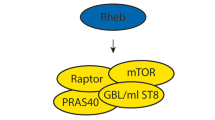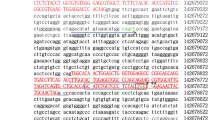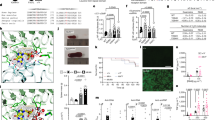Abstract
Homozygous inactivation of a gene, as is frequently performed to generate mouse models, provides an opportunity to elucidate the role that the gene plays in normal physiology. However, studies of human disease provide direct insight into the effect of inactivating mutations in man. In this investigation, we have identified a one year–old boy from a consanguineous pedigree who is homozygous for deletion of the insulin receptor gene resulting in leprechaunism. Contrary to previous predictions, the complete deletion of the insulin receptor gene is compatible with life.
This is a preview of subscription content, access via your institution
Access options
Subscribe to this journal
Receive 12 print issues and online access
$209.00 per year
only $17.42 per issue
Buy this article
- Purchase on Springer Link
- Instant access to full article PDF
Prices may be subject to local taxes which are calculated during checkout
Similar content being viewed by others
References
Rifkin, H. Clinical impact of insulin. Diabetes 12, 31–37 (1963).
Denton, R.M., Brownsey, R.W. & Belsham, G.J. A partial view of the mechanism of insulin action. Diabetologia 21, 347–362 (1981).
Rosen, O.M. After insulin binds. Science 237, 1452–1458 (1987).
Czech, M.P., Klarlund, J.K., Yagaloff, K.A., Bradford, A.P. & Lewis, R.E. Insulin receptor signaling. Activation of multiple serine kinases. J. biol. Chem. 263, 11017–11020 (1988).
Taylor, S.I. et al. Mutations in the insulin receptor gene. End. Rev. 13, 566–595 (1992).
Taylor, S.I. Lilly Lecture: molecular mechanisms of insulin resistance. Lessons from patients with mutations in the insulin-receptor gene. Diabetes 41, 1473–1490 (1992).
Yang-Feng, T.L., Franke, U. & Ullrich, A. Gene for human insulin receptor: localization to site on chromosome 19 involved in pre-B-cell leukemia. Science 228, 728–731 (1985).
Seino, S., Seino, M., Nishi, S. & Bell, G.I. Structure of the human insulin receptor gene and characterization of its promoter. Proc. natn. Acad. Sci. U.S.A. 86, 114–118 (1989).
Soriano, P. et al. Targeted diruption of the c-src proto-oncogene leads to osteoporosis in mice. Cell 64, 693–702 (1992).
Rudnicki, M.A., Braun, T., Hinuma, S. & Jaenisch, R. Inactivation of MyoD in mice leads to up-regulation of the myogenic HUH gene Myf-5 and results in apparently normal muscle development. Cell 71, 383–390 (1992).
Schorle, H., Holtschke, T., Hunig, T., Schimpl, A. & Horak, I. Development and function of T cells in mice rendered interleukin-2 deficient by gene targeting. Nature 352, 621–624 (1991).
Schumacher, R. et al. Insulin and insulin-like growth factor-1 binding specificity is determined by distinct regions of their cognate receptors. J. biol. Chem. 266, 19288–19295 (1991).
Rechler, M.M. & Nissley, S.P. Insulin-like growth factors. in Handbook of Experimental Pharmacology, Vol. 95/1 Peptide Growth Factors and Their Receptors (eds Sporn, M.B. & Roberts, A.B.) 263–367 (Springer-Verlag, Berlin Heidelberg, 1991).
Liu, S.J., Perkins, A., Roberstson, E.J. & Efstradiatis, A. Targeted disruption of mouse gene encoding the IQF-I type I receptor. in Abstracts of Papers Presented in 1992 Meeting on Mouse Molecular Genetics, p. 265 (Cold Spring Harbor Laboratory Press, New York, 1992).
Snouwaert, J.N. et al. An animal model for cystic fibrosis made by gene targeting. Science 257, 1083–1088 (1992).
Dorin, J.R. et al. Cystic fibrosis in the mouse by targeted insertional mutagenesis. Nature 359, 211–215 (1992).
Ratcliff, R. et al. Production of a severe cystic fibrosis mutation in mice by gene targeting. Nature Genet. 4, 35–41 (1993).
Barbetti, F. et al. Detection of mutations in insulin receptor gene by denaturing gradient gel electrophoresis. Diabetes 41, 408–415 (1992).
Tewari, D.S., Cook, D.M. & Taub, R.J. Characterization of the promoter region and 3′ end of the human insulin receptor gene. J. biol. Chem. 264, 16238–16245 (1989).
Ullrich, A. et al. Human insulin receptor and its relationship to the tyrosine kinase family of oncogenes. Nature 313, 756–761 (1985).
Sharma, P.M., Reddy, G.R., Vora, S., Babior, B.M. & McLachlan, A. Cloning and expression of a human muscle phosphofructokinase cDNA. Gene 77, 177–183 (1989).
Cleveland, D.W. et al. Number and evolutionary conservation of alpha- and beta-tubulin and cytoplasmic beta- and gamma-actin genes using specific cloned cDNA probes. Cell 20, 95–105 (1980).
Author information
Authors and Affiliations
Rights and permissions
About this article
Cite this article
Wertheimer, E., Lu, SP., Backeljauw, P. et al. Homozygous deletion of the human insulin receptor gene results in leprechaunism. Nat Genet 5, 71–73 (1993). https://doi.org/10.1038/ng0993-71
Received:
Accepted:
Issue Date:
DOI: https://doi.org/10.1038/ng0993-71
This article is cited by
-
The dynamic clustering of insulin receptor underlies its signaling and is disrupted in insulin resistance
Nature Communications (2022)
-
Neonatal cardiac hypertrophy: the role of hyperinsulinism—a review of literature
European Journal of Pediatrics (2020)
-
Insulin exerts direct, IGF-1 independent actions in growth plate chondrocytes
Bone Research (2014)
-
Novel roles for insulin receptor (IR) in adipocytes and skeletal muscle cells via new and unexpected substrates
Cellular and Molecular Life Sciences (2013)
-
Mouse models and type 2 diabetes: translational opportunities
Mammalian Genome (2011)



